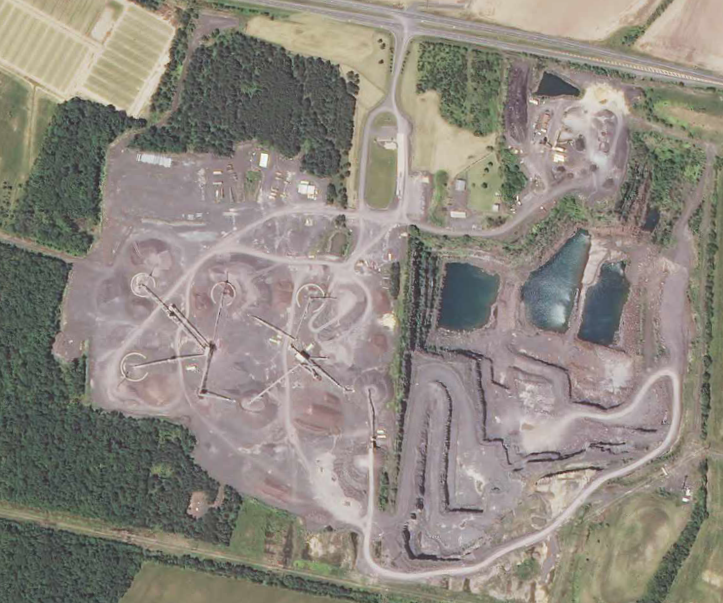
in 1989, dinosaur tracks were revealed at the Culpeper Stone Company near Stevensville
Source: US Geological Survey, Culpeper East 7.5x7.5 topographic quadrangle (2013)

in 1989, dinosaur tracks were revealed at the Culpeper Stone Company near Stevensville
Source: US Geological Survey, Culpeper East 7.5x7.5 topographic quadrangle (2013)
Dinosaurs first evolved in the Triassic Period perhaps as much as 245 million years ago, after the "Great Dying" that marks the end of the Permian Period 252 million years ago. At the time, Virginia was in the center of Pangea. The solar system was on the other side of the Milky Way galaxy, making its 250-million year rotation around the black hole in the center.1
The Archosauria group included ancestors of crocodiles as well as dinosaurs. Footprints in the Balls Bluff Siltstone within the Culpeper Basin document the presence of Eubrontes dinosaurs 220 million years ago.
The first dinosaurs struggled to compete with other animals. Diversification of dinosaurs into more species was triggered a change in climate, from humid to arid and then back to humid again, during the Carnian Pluvial Episode 234–232 million years ago. Key herbivores went extinct, creating niches for new dinosaurs to fill. However, by the end of the Triassic Period 201 million years ago dinosaurs were only 5% of the animals on earth.
As dinosaurs filled the niches, they had the advantage of walking upright compared to the sprawling gait of salamanders and lizards. Dinosaurs grew fast; no Tyrannosaurus rex survived more than 30 years. Their lungs were especially efficient at extracting oxygen and removing heat, like the lungs of modern birds today.
Species with a hip/leg arrangement for walking upright, such as the archosaurs that appeared after the Permian extinction, could move faster on land. Today's alligators and crocodiles are descendants of the pseudosuchian line of archosaurs. Today's birds are the survivors of the avemetatarsalian line, which also produced the dinosaurs of the Mesozoic Era.2
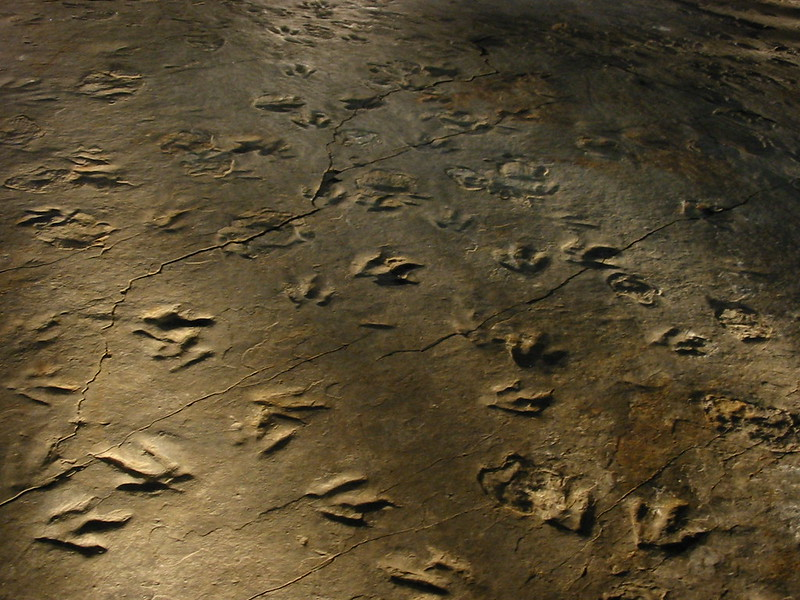
fossilized tracks of Eubrontes document that dinosaurs walked in Virginia 220 million years ago
Source: Lynn Gardner, Fossilized Dinosaur Tracks
Dinosaurs first appeared in what is now South America, but at the start of the Triassic Period there were no separate continents. The supercontinent of Pangea allowed species on land to migrate without crossing any part of the Panthalassa Ocean.
The first dinosaurs were limited to humid areas. Dry areas were a barrier to migration, and Virginia was in the middle of Pangea far from the moist coast. The distribution of dinosaurs was limited by climate and by their inability to exist in deserts.
Dinosaurs never lived in humid rainforests as portrayed in many movies, because that type of forest did not evolve until after the end of the Cretaceous Period when dinosaurs disappeared. Grazing by herbivorous dinosaurs, and trampling by their large bodies, facilitated savanna-like vegetation and prevented development of dense blocks of vegetation.
At some point after the first 20 million years of dinosaur evolution, the climate changed and/or the species developed new adaptations that allowed expansion out of the humid tropics. Some dinosaurs managed to migrate into Virginia during the Triassic.3
Dinosaur fossils were identified 2,000 years ago in China, where they were thought to be evidence of dragons. In the 1600's, bones found in England were considered evidence of a human giant. The concept of "dinosaurs" emerged in the 1840's.
Only a few dinosaur bones or teeth have ever been discovered on the East Coast of North America. During the "bone war" rivalry of paleontologists Edward Drinker Cope and O. C. Marsh after the Civil War, the focus was on excavating sites west of the Mississippi River.
Based on the records in the Paleobiology Database, Virginia is relatively rich in dinosaur fossils. The 280 records makes puts Virginia in the Top 10 of states with known fossils. The Tanytrachelos was eating insects in what is now Virginia 225 million years ago. The Solite Quarry at Cascade in Pittsylvania County, a rare location that has preserved insect fossils from the Triassic Period, also preserved evidence of Tanytrachelos.4
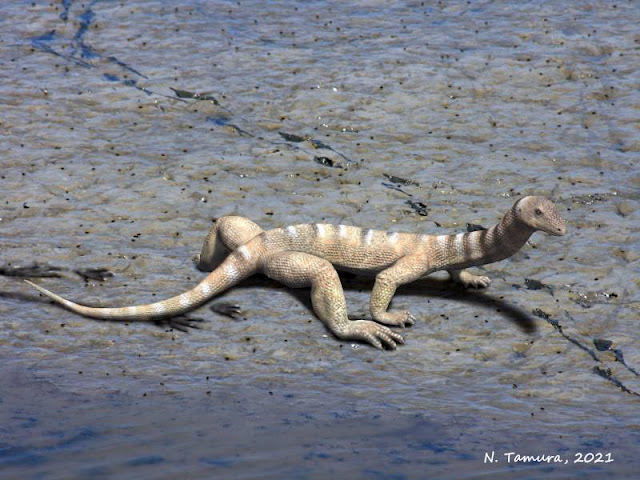
fossil evidence of Tanytrachelos has been found in Virginia
Source: Spinops, Tanytrachelos ahynis (© Nobu Tamura)
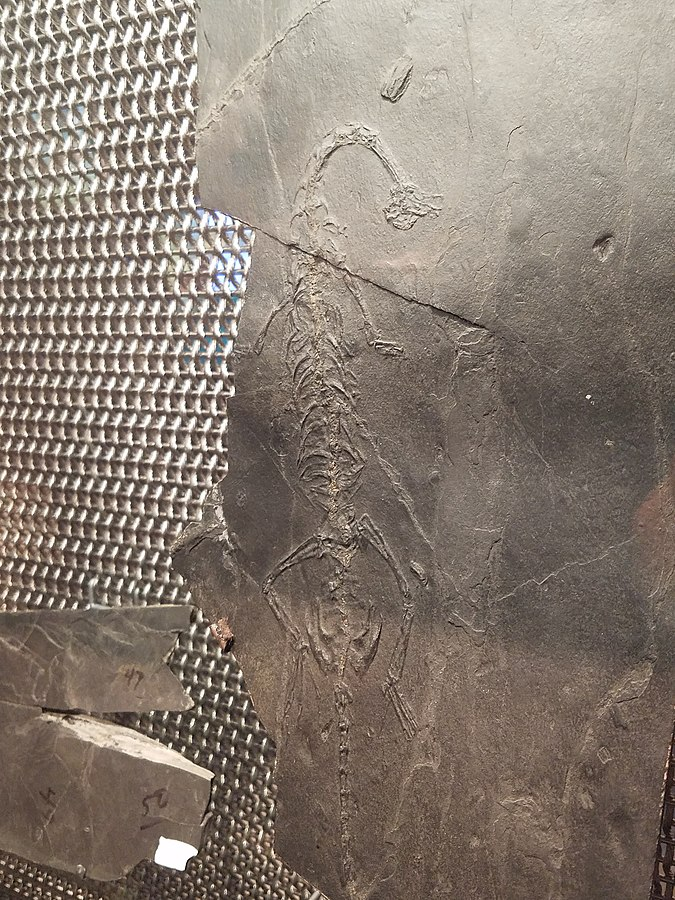
a fossil of Tanytrachelos from the Solite Quarry at Cascade, in Pittsylvania County
Source: Wikipedia, Tanytrachelos (by Fanboyphilosopher - Neil Pezzoni)
Dinosaur fossils have been excavated from former iron mining pits in "Dinosaur Alley" between Washington and Baltimore, from Cretaceous clays formed 110 million years ago. Dinosaur Park in Prince Georges County has fossils from the Cretaceous Period, dating to 115 million years ago. A "bonebed" with fossils of multiple species was discovered there in 2014. A shin bone of a 38-foot long, meat-eating Acrocanthosaurus was uncovered there in 2023. The Acrocanthosaurus was a theropod, in the same dinosaur family as Tyrannosaurus rex.5
Since dinosaurs were present in Maryland, there is clearly potential for finding parts of a dinosaur skeleton within Virginia.
Fortunately, an animal with just one skeleton can create millions of tracks in its lifetime. Those trace fossils have a greater chance of being preserved and discovered, and dinosaur footprints have been found within Virginia.
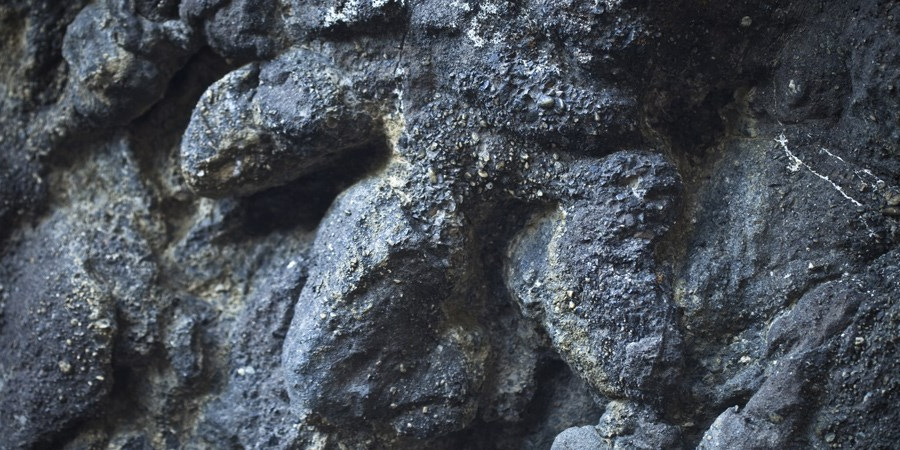
there are more trace fossils of dinosaur tracks than dinosaur bones
Source: National Park Service, Dinosaur & Plant Fossils
Herds of plant-eating dinosaurs and packs of predators walked across the muddy shorelines on the edge of lakes in Triassic Period basins. Those basins were created as the crust of Pangea cracked and the Atlantic Ocean opened up. In what is now Northern Virginia east of the Blue Ridge, a lake sometimes as much as 60 miles long and 10 miles wide existed for 30 million years. Tracks discovered in Triassic sediments show that other basins near Richmond and Danville were also home to dinosaurs.
There were no flowering plants then; they had not developed yet. At the time when dinosaurs evolved, the day was only 23 hours long. (Since then, the moon has moved further away and the earth spins more slowly.) Monsoons swept across the continent, redistributing heat and moisture. Storms created floods, and floods deposited sediments.
Roughly 20,000-25,000 feet (4-5 miles) of rock have eroded off the Blue Ridge over the last 215 million years, filling the Triassic basin to the east and depositing sediments on the west all the way to Chicago. Most of the floods that eroded the mountains washed away potential fossils. Typically the tracks of dinosaurs disappeared quickly as storms or wind moved sediments around. In addition, 50-70 million years of sediments deposited in the Middle Jurassic-Early Cretaceous have also eroded away, removing whatever evidence they once contained of dinosaurs, ferns, cycads, and the earliest flowering plants.6
Source: Virginia Museum of Natural History, "Tales of Ancient Life:" The Tale of Diorocetus
Occasionally, the ancient dinosaur trackways have been preserved and exposed later by quarry excavations.
Animals that lived alongside the dinosaurs have been identified from those pits, including Pleurocoelus nanus, Pleurocoelus altus, Priconodon crassus, Allosaurus medius, and Coelurus gracilis. In the District of Columbia, the thighbone of a 10-ton Astrodon (which could reach foliage as high as 33 feet) was excavated from the McMillan water treatment plant. Fossil remains of the Rutiodon phytosaur were found near Dulles Airport and at Solite Quarry near Danville.
In 2012, a visitor to NASA's Goddard Space Flight Center in Maryland discovered a trackway in the Patuxent Formation deposited during the Cretaceous Period. There were 70 footprints from theropods, sauropods, nodosaurs, pterosaurs, and small mammals species. The specific trackway may record the foragers that crossed a muddy area within a period of several hours or days, and the animals that hunted the foragers.7
Tracks remain deeply buried in most cases, but occasionally are exposed. Dinosaur State Park in Connecticut has an extraordinary display of Eubrontes tracks, exposed when the state highway department was constructing a building and preserved because a bulldozer operator quickly recognized that he was about to destroy a rare resource.8
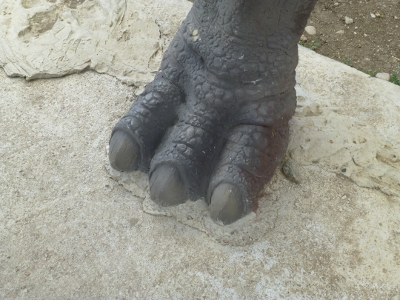
ichnofossils (traces of dinosaurs) were formed 200+ million years ago when dinosaurs stepped on mud
The landscaping at Oak Hill, President Monroe's former home in Loudoun County, was enhanced with new walkways in 1920. Sandstone slabs were excavated from the quarry 3,800 feet north of the house. In those slabs were dinosaur footprints, which are highlighted today in the sidewalks, patios, and floors at Oak Hill.
The tracks of two dinosaur species, Grallator and Eubrontes, are distinctive three-toed footprints Those tracks are trace fossils and not associated with specific bones. Grallator was a meat-eating dinosaur that sprinted on two legs. Eubrontes was a larger predator, reaching 20 feet in length. Until more fossils are discovered, most characteristics of the dinosaurs that made the tracks will remain a mystery.9
Dinosaur tracks have been found in the Richmond, Danville, and Culpeper basins. The most impressive set of fossil footprints discovered so far in Virginia come from the Culpeper Stone Company quarry (now owned by Luck Stone) in Stevensville, near Culpeper. The quarry workers who initially discovered the tracks were not paleontologists, but realized the depressions in the bedrock were significant. As one said:10
Over 4,800 footprints of dinosaurs and other species were preserved on two levels. On a low level of the quarry are 2,300 Kayentapus footprints aligned into twenty trackways. These were made by dinosaurs 10-13 feet long that moved at nearly 20 miles per hour. Kayentapus was a theropod carnivore, probably hunting ornithischians (dinosaurs with bird-like hips) while avoiding other predators that would eat a Kayentapus.11
Analysis of 830 separate footprints at a higher level has revealed 32 separate trackways with six distinctive patterns. The different species thought to have made those tracks are Gregaripus bairdi, Agrestipus hottoni, Apatichnus minor, Anchisauripus parallelus, plus trackmakers Eubrontes and the smaller Grallator. Gregaripus bairdi and Agrestipus hottoni are thought to have been herbivores, while the other four were carnivores.
The tracks were all made within a few days of each other, and the Gregaripus was running at nearly seven miles/hour. Random chance may have favored the retention of more footprints from carnivores, or perhaps they had gathered in large numbers in anticipation of the herbivores migrating though the area.12
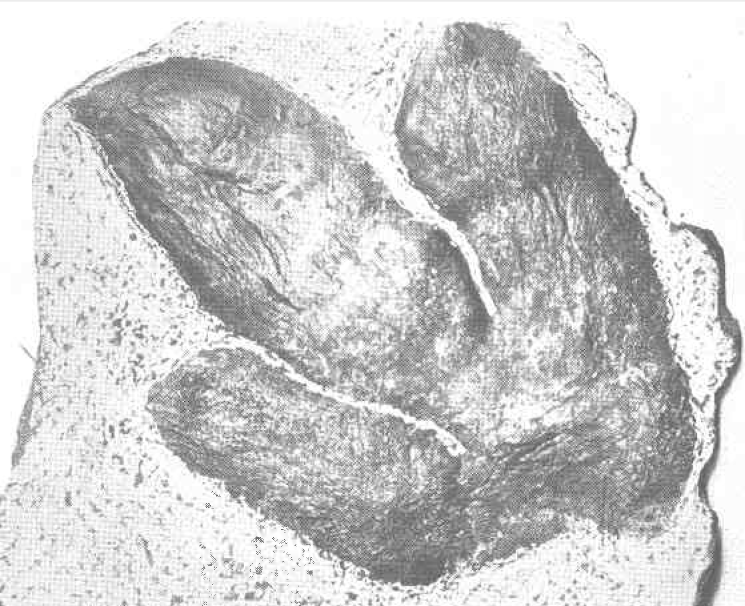
dinosaur track from near Aldie
Source: Virginia Geological Survey, The Geology of the Virginia
Triassic (Plate 31)
At the Solite Quarry on the Virginia-North Carolina border near Danville, Atreipus footprints are associated with a particular 10-million year period in the Late Triassic. Near Manassas, Apatopus, Brachuchirotherium, Chirotherium, and Grallator tracks have been documented.13
Along the Rappahannock River, a research geologist and amateur paleontologist recognized that the local Cretaceous sediments in Spotsylvania County should contain trace fossils. After using a boat to explore the riverbank, they found tracks of the herbivore Sauroposeidon, which grew to 70 feet in length. A footprint preserved in stone was 3-feet by 1.5-feet in size.
They also found footprints of Iguanadont, Hypsilophodont, Archaeornithomimus, Priconodon, Eolambia, and Irenesauripus, plus non-dinosaur species. In 2016, geologist Robert E. Weems spotted dinosaur footprints in flagstones at Belmont, the Gari Melchers Home and Studio in Stafford County.
Those stones had been quarried from the local Patuxent Formation, which was deposited about 110 million years ago in the Cretaceous Period. They were used originally at Mannsfield, a different plantation south of Fredericksburg built in 1776 by Mann Page that burned in the Civil War. In the 20th Century, the Melchers purchased the stones for use in an outdoor garden. No one spotted the footprints for about a century.
Weems and Jon Bachman, his paleontologist partner, determined that the tracks at Belmont came from six dinosaur species plus a crocodilian. One footprint was made by an Astrodon johnstoni juvenile. Others were made by Acrocanthosaurus, Amblydactylus, Hypsiloichnus, Tetrapodosaurus and Brontopodus dinosaurs.14
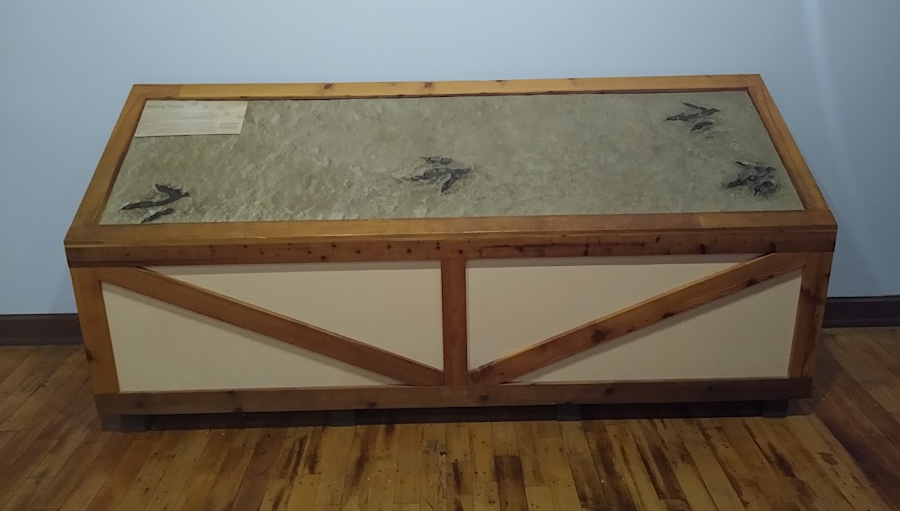
the only remnants of dinosaurs found in Virginia are their footprints in once-muddy Triassic basins, now displayed in museums
Tyrannosaurus rex is the most famous dinosaur species, but it was never in Virginia. After the high temperatures of the Cretaceous Thermal Maximum 92 million years ago, followed by significant cooling, ancestors of the tyrannosaur genus evolved 80-85 million years ago during the Middle Jurassic in China. The ancestor species migrated from Siberia into North America.
Based on fossils discovered to date, some tyrannosaurs moved back into Siberia 78 million years ago. There they developed into the large, unrivaled predators highlighted in so many museum exhibits and movies.
Another migration 68 million years ago brought back into North America the dinosaur species that evolved into Tyrannosaurus rex.
A Tyrannosaurus rex ate 250 pounds of meat daily. It had teeth and jaws so powerful that it became the hardest-biting terrestrial animal of all time. It was the only dinosaur whose teeth could puncture straight through the bones of its prey. When a movie shows a Tyrannosaurus rex biting through a car, the scene reflects actual jaw-crushing capability.
That dinosaur species could move up to 25 miles per hour for a brief chase. It typically hunted in packs, ambushing prey with a short burst of energy. An assessment of intelligence known as the encephalization quotient, based on the ratio of the size of the brain to the size of the entire animal, suggests the Tyrannosaurus rex was as smart as modern chimpanzees.
Tyrannosaurus rex, like many species of dinosaurs, had feathers 66 million years ago. They were used for display and controlling body temperature, but some species of dinosaurs at that time were also flying with feathered wings.
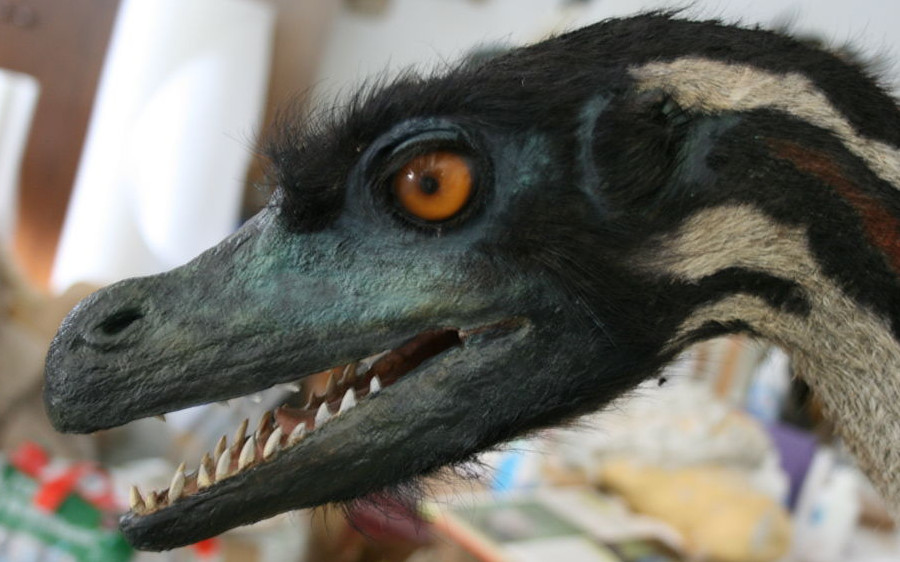
artists speculate on the appearance of dinosaurs, reflecting the discovery of feathers and melanosomes in fossils
Source: Artificial Animals (by Salvatore Rabito Alcon)
The evolution into Tyrannosaurus rex occurred in western North America, on a slice on continental crust known to geologists now as Laramidia. Its fossils are found in Wyoming, Montana, and Alberta (Canada). The time in North America for T. rex as a separate species was short. It disappeared when an asteroid slammed into the Gulf of Mexico 66 million years ago.15
The migration of Tyrannosaurus rex to Eastern North America was blocked by the Western Interior Seaway. High water levels in the Cretaceous Period flooded the middle of the continent. The Arctic Ocean and the Gulf of Mexico were connected by the seaway, splitting the North American continent. Laramidia on the west was connected to Asia, but Appalachia on the eastern side of the seaway was isolated for 27 million years.
Dinosaur species developed independently on the separate sides of the seaway. No one has found evidence of a Tyrannosaurus rex in Virginia, or anywhere in the slice of crust called Appalachia; it evidently could not tolerate salt water. In contrast, ancestors of modern crocodiles had the capacity to excrete salt (sodium chloride). They could cross the Western Interior Seaway, and feed on whatever dinosaurs they found near the coastlines.
There may have been fewer species in the east, but preservation in Appalachia was also different. Bones of dinosaurs in Laramidia were preserved in river channels near the point of death. In Appalachia, most bones found to date appear to have washed downstream into the Western Interior Seaway. There are fewer fossils found, though the number of dinosaurs per square mile may have been similar in Laramidia and Appalachia:16
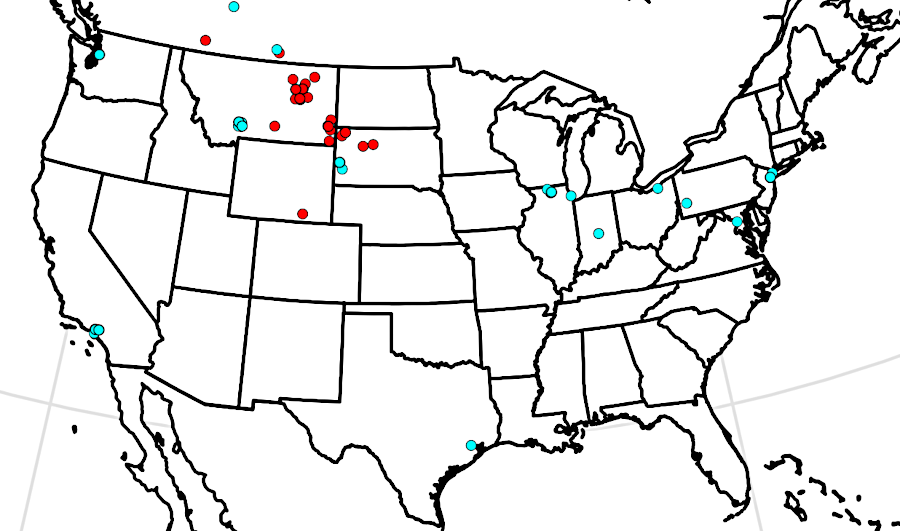
fossils of Tyrannosaurus rex have been found (red dots) on only one side of the Western Interior Seaway, but are displayed in museums (blue dots) across North America
Source: Start Your Week With a Map, Answer to Map #107 (December 3, 2018)
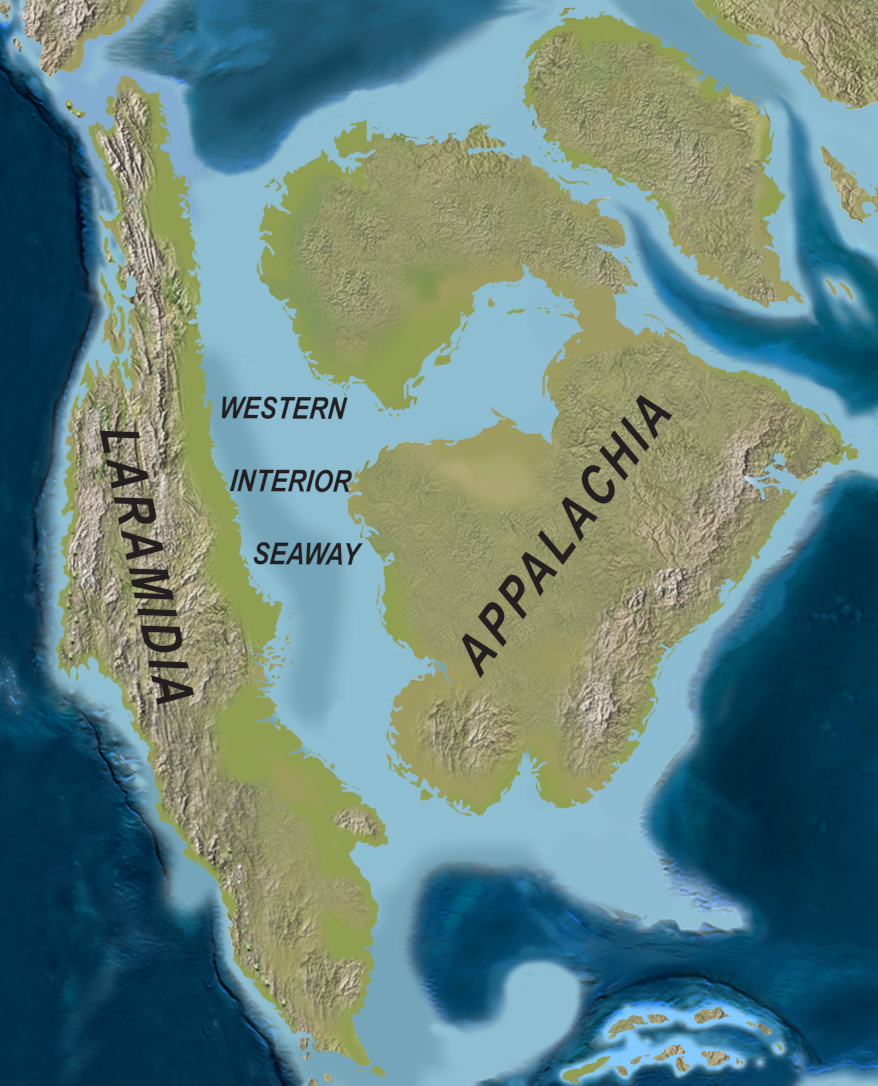
the Western Interior Seaway separated Appalachia from Laramidia, the territory of Tyrannosaurus rex after it evolved during the Cretaceous Period
Source: US Geological Survey, New Horned Dinosaurs from Utah Provide Evidence for Intracontinental Dinosaur Endemism (published in PLOS One, September 22, 2010)
Almost all of the dinosaurs died out in Virginia and across the world after a catastrophic asteroid impact 66 million years ago. For 200,000 years prior to the impact, volcanic eruptions in what today is India may have initiated repeated short-lived global drops in temperature that were unfavorable to the dinosaurs. The eruptions at the Deccan Traps ("traps" comes from a Swedish word for "step," reflecting the appearance of layers of lava that eroded at different rates) poured sulfur and fluorine into the atmosphere, reflecting sunlight.
The global cooling may not have been sufficient to induce a mass extinction, but the volcanic winters altered environmental conditions. Ecosystems were destabilized for several hundreds of thousands of years before the impact 66 million years ago.17
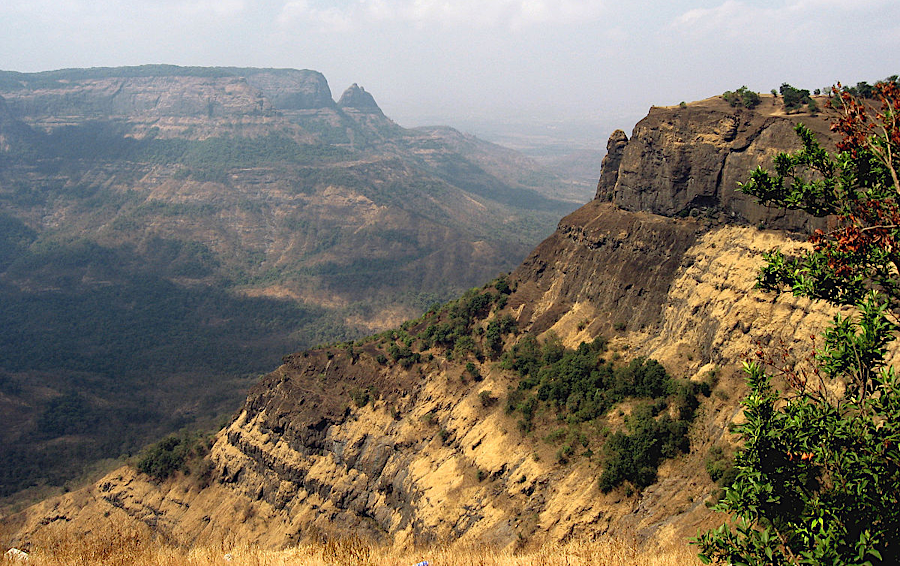
lava flows in India remain from volcanic eruptions that destabilized ecosystems before the Chicxulub impact 66 million years ago
Source: Wikipedia, Deccan Traps
Speculation about the object has included the possibility that it was a comet. Based on ruthenium isotopes in the residue generated by the impact, it was a C-type (carbonaceous) asteroid from the middle or outer asteroid belt, perhaps beyond the orbit of Jupiter. Most objects that strike the Earth are smaller, S-type (silicate) asteroids.18
The giant asteroid was six to nine miles wide, the size of Mount Everest. It was traveling at over 50,000 miles per hour when it landed in the Gulf of Mexico and formed the Chicxulub crater, now located at the edge of the Yucatan peninsula. The asteroid was vaporized along with the water and rock at the bottom of the ocean. The impact carved out a hole over 12 miles deep, far enough to punch through the crust and reach the upper mantle.
The asteroid, steam, and vaporized carbonate and sulphate rocks from the ocean bottom were blasted high into the atmosphere. A cloud of gas and molten particles spread outward in all directions from a crater 125 miles wide. Air currents at high altitude then carried the cloud around the world.
No place on Earth was safe or unaffected. Some particles must have landed on the moon, and some may be discovered on Mars someday. When incandescent shards of rock fell back to the surface, the atmosphere at ground level was heated to the temperature of a modern pizza oven.

when they landed, molten particles that had been blasted into atmosphere triggered fires across the planet
Source: NASA Universe, Asteroid that created Chicxulub crater
The Clayton Formation in southeastern Missouris appears to have been deposited within one day by a megatsunami. The massive wave, pushing forward materials that were deposited in Missouri, was created when the asteroid displaced water in the Gulf of Mexico.
Scientists have excavated a deposit in North Dakota with glass beads in the gills of fossilized fish and in amber (fossilized tree sap), remnants from the actual day of impact. The evidence there shows the impact occurred in early Spring, when animals were emerging from winter hibernation and were not in peak condition.19
Wildlife and plants exposed on the surface were pelted by the hot particles. They ignited organic material directly, and the hot, hot air set grasslands and forests on fire. In what is now Virginia, it is likely that every animal and every plant that was not in a burrow or water was baked or burned to death. Black ash covered the earth's surface at the end of that dramatic day. Once-blue lakes and streams were grey with suspended soot, or black with a floating cover of once-green plants.
However, there may have been pockets of the Earth's surface (perhaps on the other side of the planet from the impact site) that were not torched due to wind currents deflecting the pattern of falling debris. The entire world did not catch fire on one day.
After the impact, earthquakes exceeding anything experienced in modern times rocked the Western Hemisphere. Winds from the blast wave and the atmospheric heating exceeded the force of hurricanes and blasted the scorched landscape for hundreds of miles around the impact. The sulfur in the geologic deposits that were blasted into the atmosphere would have generated an acid rain that fell across the world.
While the winds that reached Virginia may have been below hurricane force, the massive amount of water displaced by the asteroid impact swept across the Gulf of Mexico and Atlantic Ocean shorelines. After the impact, ocean current patterns were disrupted a second time by the fast return of water into the impact crater, which was briefly empty after the heat of collision caused a column of the ocean to flash into steam.
The disruption at the impact site triggered tsunamis and seiche waves across the world. One wave, perhaps 50 feet high, swept inland from the Atlantic Ocean. It would have swept away the ash and whatever charred remains of dead dinosaurs were still on the surface of Virginia's Coastal Plain.
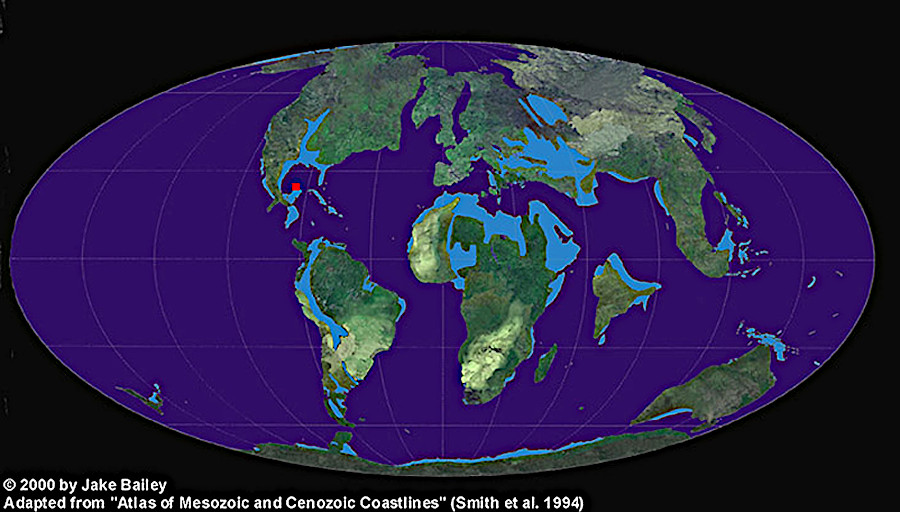
the impact event that killed off the dinosaurs occurred about 1,200 miles from Virginia (red square), but the location of shorelines and tectonic plates was different 66 million years ago
Source: Center for Lunar Science and Exploration, Cretaceous-Tertiary (K-T) Boundary (by Jake Bailey, 2000)
After the initial stunning effects, soot remaining in the atmosphere darkened the sky. That blocked sunlight and triggered a period of global cooling. Tiny particles of soot circulated in the atmosphere for months and years.
Raindrops ultimately brought the soot particles to the earth's surface. Those raindrops included sulfur, in part from the vaporized organic material and in part because the asteroid hit where bedrock was rich in gypsum (CaSO4).
The sulfur reacted with the water in the atmosphere, acid rain fell from the skies, and the chemistry of lakes and the ocean shifted. The changes in temperature, acidity, and sunlight were too fast for the species to adapt by gradual evolutionary change. The impact killed 70% of the species on land and in the oceans. The vacated niches were filled by new forms of life as mammals replaced reptiles.
All the dinosaurs that had survived the environmental changes triggered by Deccan Trap eruptions, and not within underground burrows, are thought to have died in a brief period. Those not killed on the very day of the impact died soon afterwards from the sudden drop in temperature and starvation. Herbivores who somehow survived the impact ran out of food when vegetation died in the global winter. Meat-eating dinosaurs may have had a brief feast, but their food sources disappeared after carcasses rotted.
It is possible that every single dinosaur in what is today Virginia died within hours of the Chicxulub impact. All dinosaur species across the world disappeared, except a few which survived long enough to evolve into new species that adapted to the new post-impact environment.
Though the Chicxulub event was catastrophic, it did not sterilize the Earth. About 25% of the species survived during the "impact winter" when dust obscured the sun and temperatures grew cold. Plants regrew from seeds and roots. Animals who survived were able to find shelter underground on the day of the impact, when fire rained from the sky.
Dinosaurs included large herbivores that maintained trees on a savanna-like pattern of vegetation. Without the trampling and eating, trees finally grew in thick clumps and forests became crowded. In the fight for light that drives photosynthesis, vines evolved to climb trees. Grape vines developed in South America about 6 million years after the asteroid created the Chicxulub crater; extinction of the large herbivores led to the creation of wine.
Animals who emerged, and perhaps were already adapted to feed on seeds and carrion, managed to get through the time when photosynthesis was interrupted by a dust-filled atmosphere. Only one group of dinosaurs found a way to continue; modern birds are their descendants.20
In addition to the birds still in Virginia, there are fossilized dinosaur skeletons in museums. There are also foam, plastic, plaster, and fiberglass dinosaurs at parks such as Dinosaur Land in Clarke County. That attraction in White Post, which opened in 1967, was created by a gift shop owner who wanted to get tourists to stop and shop. The 50 sculptures include large sharks, a wooly mammoth, and a 70-foot long octopus.
A company that organizes outdoor events takes 75 or more dinosaurs out of its Virginia Beach warehouse and stages them where customers can drive though a "Jurassic Encounter," paying about $50 per car. During an hour-long encounter with dinosaurs, the audio system within a visitor's car plays a narration that is intended to be both entertaining and educational. The company invests significant effort to recreate a Jurassic site highlighting now-extinct reptiles:21
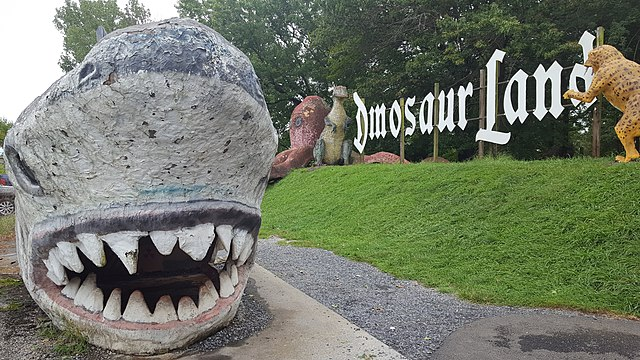
entrance to Dinosaur Land near Winchester
Source: Wikipedia, Virginia Museum of Natural History (photo by Skvader)
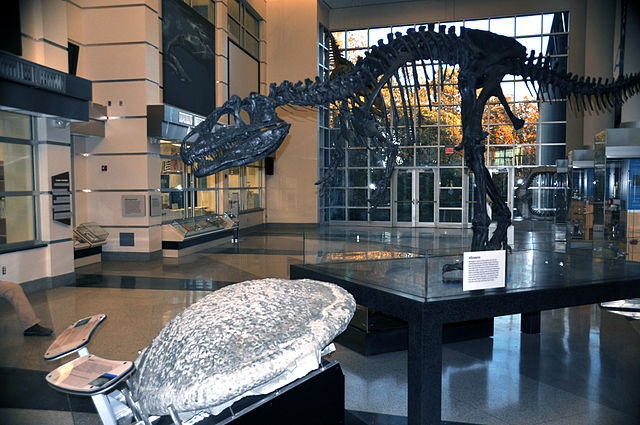
dinosaur skeleton at the Virginia Museum of Natural History in Martinsville
Source: Wikipedia, Virginia Museum of Natural History (photo by James St. John)